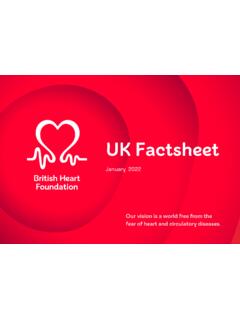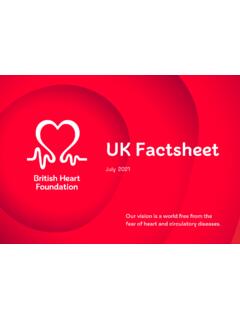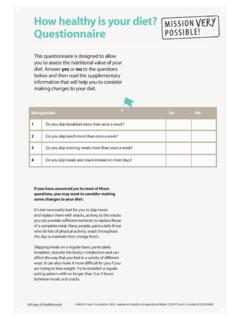Transcription of BHF Physical Inactivity Report 2017
1 Physical Inactivity and Sedentary Behaviour Report 2017. ABOUT THE BRITISH HEART FOUNDATION (BHF). We fight. For an end to heart disease, for an end to the fight for every heartbeat, everywhere. Until we win. For over 50 years, we've pioneered life saving research. And already, we've helped halve the number of people dying from heart and circulatory disease in the UK. Tomorrow, we'll break new ground, create new treatments, discover new cures. So one day, we'll beat heart disease for good. ABOUT THIS Report . The British Heart Foundation (BHF) has compiled this Report using the latest health statistics to provide a comprehensive overview of levels of Physical Inactivity and sedentary behaviour in adults across the UK. The Government recommends that adults undertake at least 150 minutes of moderate intensity Physical activity a week and strength activities on at least two days a week.
2 It is also recommended that adults minimise their levels of sedentary behaviour. The data in this Report suggests that large numbers of people in the UK are still failing to meet recommendations for Physical activity, putting them at greater risk of heart and circulatory disease. The statistics also show that levels of sedentary behaviour in the UK remain stubbornly high. This is of particular concern as evidence is growing which shows that sedentary behaviour time in which energy expenditure is very low is an independent risk factor to Physical Inactivity . ABOUT MYMARATHON. We must find ways to help make Physical activity an important part of everyone's routine. The BHF's MyMarathon challenge is the perfect activity to help ease people into increasing their Physical activity. Participants can complete the challenge in their own time over the month of May, whether that's over 4 hours, 4 days or 4 weeks, meaning it can even be completed by running as little as a mile a day.
3 Every pound raised from MyMarathon will help the BHF fulfil its ambition to fund half a billion pounds of new research in the next five years, to revolutionise and accelerate the fight against heart disease. Foreword Physical Inactivity is a global health crisis, responsible for an estimated 5million deaths worldwide . This Report highlights the significant problem that this presents in the UK, and its terrible burden on people's health. Around 20 million adults in the UK are insufficiently active, putting them at a significantly greater risk of heart and circulatory disease, and premature death. Levels of sedentary behaviour also remains stubbornly high in the UK, and evidence is growing that shows a sedentary lifestyle, irrespective of your level of Physical activity, is strongly associated with poor cardiovascular health.
4 Combined these two risk factors present a considerable threat to people's individual risk of heart and circulatory disease. The impact of Physical Inactivity and sedentary lifestyles also weighs heavily on UK healthcare, estimated to cost as much as billion a year. Making Physical activity easier and more accessible for all is of paramount importance if we are to reduce the burden of Inactivity -related ill health and improve the future cardiovascular health of our population. The BHF's MyMarathon challenge is the ideal opportunity for people of all fitness levels to increase their Physical activity, whilst helping support our vital research. More than 30,000 people took park last year and we hope even more will this year, as a stepping stone towards better heart health. Dr Mike Knapton, Associate Medical Director at the British Heart Foundation Physical Inactivity across the Four Nations Keeping physically active is proven to help reduce your risk of heart and circulatory disease by helping you maintain a healthy weight, and reduce your blood pressure and cholesterol.
5 The Government recommends adults need to do at least 150 minutes of moderate intensity activity a week and strength activities on two or more days a week. However, statistics show there are still large numbers of people across the UK who are failing to meet these recommendations, which is likely to have a negative impact on their health. The UK analysis of the Global Burden of Diseases, Injuries and Risk Factors Study found Physical Inactivity and low Physical activity to be the fourth most important risk factor in the UK for premature death from any cause, including coronary heart disease. According to the latest health surveys: Around 39% of UK adults that's around 20 million people are failing to meet Government recommendations for Physical activity. Around women across the UK are insufficiently active, compared to around men.
6 Overall women are 36% more likely to be classified physically inactive then men. In Northern Ireland almost half (46%) of the adult population that's around 650,000 people are physically inactive. In Scotland almost two fifths (37%) of the adult population that's around people are physically inactive. In Wales over two fifths (42%) of the adult population over 1million people are physically inactive. According to a BHF survey, around 60% of adults are unaware of the Government's Physical activity guidelines. BHF-funded research, at Oxford Research funded by the BHF has shown exercise could University, showed middle-aged women stimulate dormant stem cells in the heart to trigger the could significantly lower their risk of heart formation of new heart muscle cells. The findings, from Liverpool disease and stroke by exercising even just John Moores University, showed in rats that doing regular, two or three times a week.
7 The study, of over intense exercise could reactivate specialist cardiac stem cells that one million UK women, showed women are usually dormant in the adult heart, resulting in the formation who did strenuous Physical activity two to of new blood vessel and heart muscle cells. three times a week, or any activity up to four to six times a week, had around a 20% lower The results of this study could bring hope for new treatments to risk of coronary heart disease, stroke and mend and regenerate damaged heart muscle after a heart blood clots compared to women who were attack. inactive. Physical Inactivity in England regions Physical Inactivity remains consistently high in all regions across England. In England alone there are million adults who are insufficiently active. According to the latest health surveys:- The North West has the highest proportion of people who are not meeting the Government's Physical activity recommendations.
8 Almost half (47%) of the adult population in the North West that's people are physically inactive. The South East has the lowest proportion of people who were failing to meet Government guidelines, with 34% around people not keeping active enough. Table 1 shows the level of Physical Inactivity in adults in all four nations across the UK, and the nine regions in England. Physical Inactivity LEVELS ACROSS THE UK. Nation Percentage of adults Number of adults Number of women who Number of men who who are physically who are physically are physically inactive are physically inactive inactive inactive England 39% 16,800,000 9,900,000 6,900,000. Scotland 37% 1,620,000 930,000 690,000. Wales 42% 1,030,000 600,000 430,000. Northern Ireland 46% 650,000 370,000 280,000. United Kingdom 39% 20,100,000 11,800,000 8,300,000.
9 Physical Inactivity LEVELS IN THE ENGLISH REGIONS. North East 42% 900,000 570,000 330,000. North West 47% 2,640,000 1,510,000 1,130,000. Yorkshire and the Humber 40% 1,720,000 1,050,000 670,000. East Midlands 39% 1,460,000 840,000 620,000. West Midlands 40% 1,810,000 1,040,000 770,000. East of England 37% 1,750,000 980,000 770,000. London 40% 2,670,000 1,610,000 1,060,000. South East 34% 2,370,000 1,410,000 960,000. South West 35% 1,550,000 950,000 600,000. Sedentary behaviour Sedentary behaviour refers to a number of individual behaviours in which energy expenditure is very low and sitting or lying is the dominant mode of posture. Research suggests a sedentary lifestyle is associated with an increased risk of heart and circulatory disease and general poor health. Sedentary behaviour is an independent risk factor to Physical Inactivity , meaning that even individuals who are sufficiently active at the recommended levels, are at increased risk if they spend large amounts of time sitting.
10 In 2011, the Chief Medical Officer issued the Start Active, Stay Active Report which provided the first recommendations around sedentary behaviour. The Report recommends that both children and adults should minimise the amount of time spent being sedentary for extended periods. The BHF estimates that the average man in the UK spends the equivalent of 78 days each year sitting. The average woman in the UK spends around 74 days each year sitting. According to Ofcom the average UK adult spends 1,779 minutes almost 30 hours a week watching TV. This is equivalent to 64 days a year. Health implications of Physical Inactivity According to a study published in the Lancet, over 5million deaths worldwide are attributed to Physical Inactivity . The World Health Organization ranks sedentary behaviour among the 10 leading causes of death worldwide .





